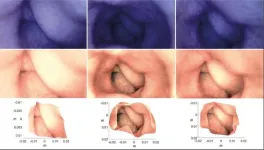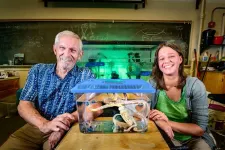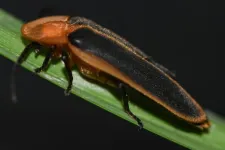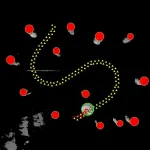(Press-News.org) OAK BROOK, Ill. – The structural and functional organization of the brain as shown on MRI can predict the progression of brain atrophy in patients with early-stage, mild Parkinson’s disease, according to a study published today in Radiology, a journal of the Radiological Society of North America (RSNA).
Parkinson’s disease is a progressive disorder characterized by tremors, slowness of movement or rigidity. Symptoms worsen over time and may include cognitive impairment and sleep problems. The disease affects more than 8.5 million people worldwide, and prevalence has doubled in the past 25 years, according to the World Health Organization (WHO).
One of the distinctive features of Parkinson’s disease is the presence of altered versions of the protein alpha-synuclein in the brain. Normally present in the brain, this protein accumulates as misfolded clumps inside nerve cells in Parkinson’s disease, forming structures known as Lewy bodies and Lewy neurites. These clumps spread to other brain regions, damaging nerves.
Researchers wanted to see if mapping the structural and functional connections across the brain could be used to predict patterns of atrophy spread in patients with mild Parkinson’s disease.
They used MRI data from 86 patients with mild Parkinson’s disease and 60 healthy control participants to generate the connectome, a structural/functional map of the brain’s neural connections. The researchers used the connectome to develop an index of disease exposure.
Disease exposure at one year and two years was correlated with atrophy at two years and three years post-baseline. Models including disease exposure predicted gray matter atrophy accumulation over three years in several areas of the brain.
“In the present study, brain connectome, both structural and functional, showed the potential to predict progression of gray matter alteration in patients with mild Parkinson’s disease,” said study coauthor Federica Agosta, M.D., Ph.D., associate professor of neurology at the Neuroimaging Research Unit of IRCCS San Raffaele Scientific Institute in Milan, Italy.
The findings support the theory that functional and structural connections between brain regions may significantly contribute to Parkinson’s disease progression.
“The loss of neurons and accumulation of abnormal proteins can disrupt neural connections, compromising the transmission of neural signals and the integration of information across different brain regions,” Prof. Agosta said.
The study results point to a role for MRI in intervention trials to prevent or delay the disease progression—especially when individual patient information is incorporated into the model. Since Parkinson’s disease progression likely differs among individuals, future models should consider different starting conditions and incorporate individual-specific information for optimal effectiveness, according to Prof. Agosta.
“We believe that understanding the organization and dynamics of the human brain network is a pivotal goal in neuroscience, achievable through the study of the human connectome,” she said. “The idea that this approach could help identify different biomarkers capable of modulating Parkinson’s disease progression inspires our work.”
###
“Brain Connectivity Networks Constructed Using MRI for Predicting Patterns of Atrophy Progression in Parkinson’s Disease.” Collaborating with Prof. Agosta were Silvia Basaia, Ph.D., Elisabetta Sarasso, M.Sc., Roberta Balestrino, M.D., Tanja Stojkovic, M.D., Ph.D., Iva Stanković, M.D., Ph.D., Aleksandra Tomić, M.D., Ph.D., Vladana Marković, M.D., Ph.D., Francesca Vignaroli, M.D., Elka Stefanova, M.D., Ph.D., Vladimir S. Kostić, M.D., Ph.D., and Massimo Filippi, M.D., F.E.A.N., F.A.A.N.
Radiology is edited by Linda Moy, M.D., New York University, New York, N.Y., and owned and published by the Radiological Society of North America, Inc. (https://pubs.rsna.org/journal/radiology)
RSNA is an association of radiologists, radiation oncologists, medical physicists and related scientists promoting excellence in patient care and health care delivery through education, research and technologic innovation. The Society is based in Oak Brook, Illinois. (RSNA.org)
For patient-friendly information on brain MRI, visit RadiologyInfo.org.
END
The School of Computer Science at Carnegie Mellon University has launched the CMU TechBridge Coding Bootcamp to provide access to computer science education and career opportunities for high school (or equivalent) graduates.
The bootcamp will extend the reach of CMU’s computer science education offerings beyond its traditional undergraduate and graduate programs. CMU has partnered with TalentSprint to implement the program to help aspiring professionals build the skills required for launching and ...
Weill Cornell Medicine received a $1.5 million grant from the U.S. Department of Defense Prostate Cancer Research Program to develop new approaches for predicting the spread of cancer cells to the bone in men with prostate cancer, using tumor samples taken at early stages of the disease.
The American Cancer Society projects about 35,250 deaths from prostate cancer in the United States in 2024. “Metastases, especially to the bone, is the leading cause of death in men who have prostate cancer,” said principal investigator Dr. Mohamed Omar, assistant professor of research in pathology and laboratory medicine, division ...
“Our work shows that it is possible to re-create a fairly accurate three-dimensional (3D) model of the colon of some patients based on a single image taken by a capsule endoscopy camera - even if it's a low-quality image,” says Pål Anders Floor, a researcher at the Department of Computer Science at NTNU.
Goal: better images, faster diagnoses
He has been working for several years on using images from capsule endoscopy cameras to reconstruct an almost identical 3D model of the intestines. These cameras were first used more than 20 years ago, but low-quality images and image noise prevented this smart technology from ...
Falls are the most common cause of injury among adults 65 and older in the United States. According to the U.S. Centers for Disease Control and Prevention, every year, more than 14 million older adults (one in four) report a fall. About 90% of head injuries among older individuals is due to ground-level falls.
Evaluating an older adult with a head injury in the emergency department (ED) requires careful assessment due to the increased risk of complications such as intracranial hemorrhage. There also is heightened concern for older patients taking anticoagulants or blood thinners who sustain ...
Fertilizers manufactured from the sludgy leftovers of wastewater treatment processes can contain traces of potentially hazardous organic chemicals, according to a new study by Johns Hopkins University researchers.
The research, published today in Environmental Science & Technology journal, provides one of the most comprehensive looks at the chemical composition of so-called biosolids across the country and is the first step toward identifying common chemical contaminants that may need government regulation. The findings could ...
CHAMPAIGN, Ill. — By giving artificial intelligence simple associative learning rules based on the brain circuits that allow a sea slug to forage — and augmenting it with better episodic memory, like that of an octopus — scientists have built an AI that can navigate new environments, seek rewards, map landmarks and overcome obstacles.
Reported in the journal Neurocomputing, the new approach gives AI the ability to explore and gather the information it needs to expand its spatial and temporal awareness, growing its knowledge base while learning on the job, said Ekaterina Gribkova, a postdoctoral researcher at the University of Illinois Urbana-Champaign who ...
The leading hypothesis for the origin of firefly lights has been overturned by a genomic analysis. It had been posited that the bright lights emitted by many species in the Lampyridae family of beetles—better known as fireflies—first evolved as a warning signal to predators, advertising the toxicity of fireflies, and were then repurposed as a mating signal. This explanation would account for why eggs, larvae, and pupae also glow. Ying Zhen and colleagues put the conventional wisdom to the test by compiling a family tree of fireflies and tracing the evolution of the chemical compounds ...
ASAP Launches Data-Sharing Tool with Unique Dataset of Human Postmortem-Derived Brain Samples
Aligning Science Across Parkinson’s (ASAP) launched a platform to make high-value data for Parkinson’s disease broadly available to researchers all over the world
The platform launches with data from a unique human postmortem-derived brain sequencing collection, including samples from four ASAP Collaborative Research Network (CRN) teams and 156 donors
The database will continue to expand, with 629 donors contributing to the final harmonized dataset; there will be a consistent cadence of new ...
In 2018, Arthur Ashkin won the Nobel Prize in Physics for inventing optical tweezers: laser beams that can be used to manipulate microscopic particles. While useful for many biological applications, optical tweezers require extremely controlled, static conditions to work properly.
“Optical tweezers work by creating a light ‘hotspot’ to trap particles, like a ball falling into a hole. But if there are other objects in the vicinity, this hole is difficult to create and move around,” says Romain Fleury, head of the Laboratory of Wave Engineering in EPFL’s School ...
With goals to limit CO2 emissions, many countries have set targets to phase out internal combustion vehicles in favor of electric vehicles (EVs). Japan has set a target for 20-30% of all car sales to be battery electric vehicles (BEVs) and plug-in hybrid electric vehicles (PHEVs), and 30-40% of car sales to be hybrid electric vehicles (HEVs) by 2030. The USA plans for 50% of new vehicles to be zero-emission by 2030, while Germany wants to have 15 million EVs on the road by 2030. These goals raise concerns about the raw material demand for EVs. Batteries, which account for 50% of all resources consumed in BEV production, require ...





